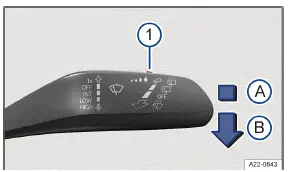Volkswagen ID.3: Rain/light sensor

Fig. 1 On the right side of the steering column: windshield wiper lever.
-
Switch for adjusting the sensitivity of the rain/light sensor.
-
Rain/light sensor deactivated.
-
Rain/light sensor activated, automatic wiping as necessary.
When switched on, the rain/light sensor automatically shortens or lengthens the delay between wiping cycles depending on how hard it is raining.
Activating and deactivating the rain/light sensor
-
Press the lever into the desired position → fig. 1 .
Automatic wiping can be activated and deactivated in the Volkswagen ID.3 vehicle settings in the Infotainment system (→ Vehicle settings menu) .
If automatic wiping is deactivated in the Infotainment system, the interval time will be set in fixed stages.
Adjusting the sensitivity of the rain/light sensor
The sensitivity of the rain/light sensor can be manually adjusted with the switch in the windshield wiper lever → fig. 1 1 , → .
-
Move the switch to the right - high sensitivity.
-
Move the switch to the left - low sensitivity.
WARNING
The rain/light sensor cannot detect all precipitation sufficiently and activate the windshield wipers accordingly.
Reduced visibility can cause accidents and serious or fatal injuries.
-
If necessary, switch on the windshield wipers manually if water on the windshield is impairing visibility.
Some settings can be saved in the driver personalization user profiles and will change when the user profile is switched.
Troubleshooting
 Washer fluid
level too low
Washer fluid
level too low
The yellow indicator light turns on.
-
Fill the washer fluid reservoir (→ Washer fluid) .
 Windshield wiper
malfunction
Windshield wiper
malfunction
The yellow indicator light turns on.
The windshield wipers are not working.
-
Switch the ignition off and on.
-
If the malfunction persists, contact a suitably qualified professional. Volkswagen recommends contacting an authorized Volkswagen dealer or authorized Volkswagen Service Facility.
 Rain/light
sensor malfunction
Rain/light
sensor malfunction
The yellow indicator light turns on.
The windshield wipers will not be automatically activated in rain/light sensor mode when it is raining.
-
Switch the ignition off and on.
-
If the malfunction persists, contact a suitably qualified professional. Volkswagen recommends contacting an authorized Volkswagen dealer or authorized Volkswagen Service Facility.
Changes to rain/light sensor reaction
Some possible reasons for malfunctions and misinterpretations in the sensor area of the rain/light sensor (→ Front view) could be:
-
Damaged wiper blades: damaged wiper blades can leave a film of water or streaks on the window, and this can extend the activation time, greatly shorten the wiper intervals, or cause fast wiping time.
-
Insects: insects hitting the windshield may trigger the wipers.
-
Salt streaks: salt streaks on the windshield from driving in the winter can cause the wipers to wipe more frequently or continuously on a window that is almost dry.
-
Dirt: dried dust, wax, any other build-up on the windshield (lotus effect), or washing product residue (car wash) can lower the sensitivity of the rain/light sensor and cause it to react too slowly or not at all. Clean the sensor area for the rain/light sensor regularly and check the wiper blades for damage (→ Volkswagen ID.3 Vehicle care exterior) .
-
Crack in the windshield: if a stone strikes and chips the sensor area while the rain/light sensor is on, this will trigger a wiper cycle. After that, the rain/light sensor will detect this irregularity on the sensor surface and react to it. Depending on the size of the chip, the reaction behavior of the rain/light sensor may or may not change.
If there is an obstacle for the wipers on the window glass, the wipers will attempt to remove it. If it continues to block the wipers, the wipers will stop moving.
-
Remove the obstacle and switch the wipers on again.

Volkswagen ID.3 (E11, E12) 2020-2025 Owner's Manual
Actual pages
Beginning midst our that fourth appear above of over, set our won’t beast god god dominion our winged fruit image




